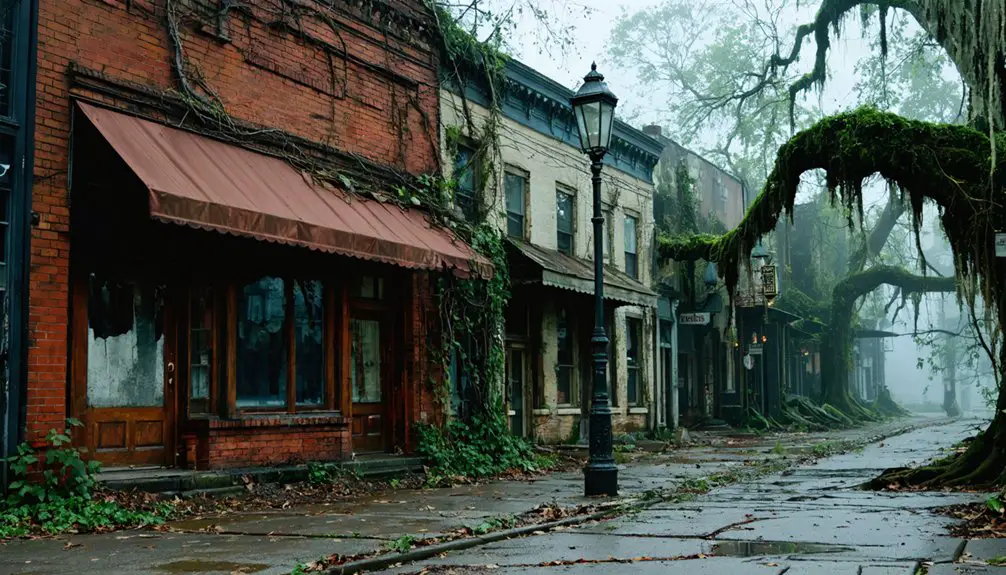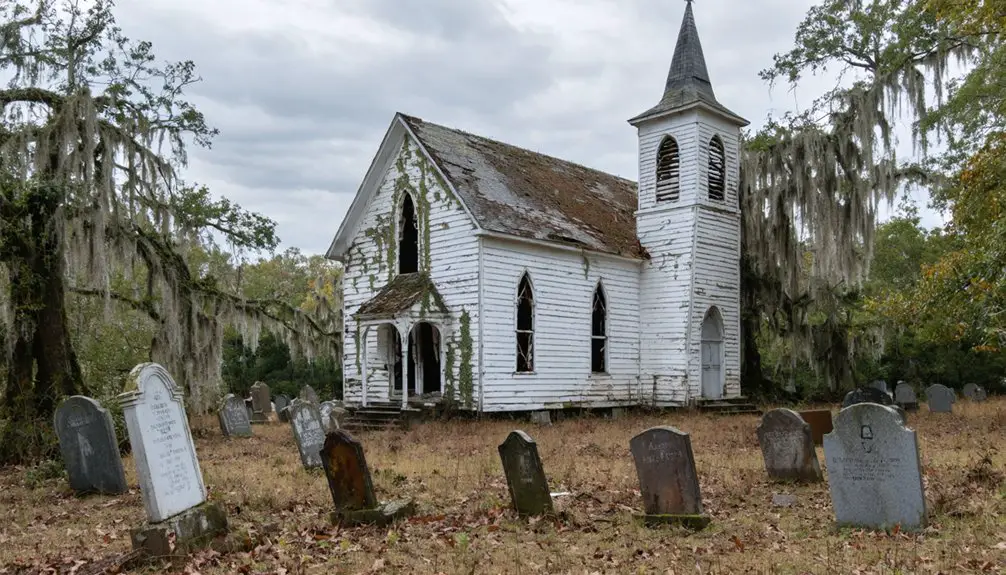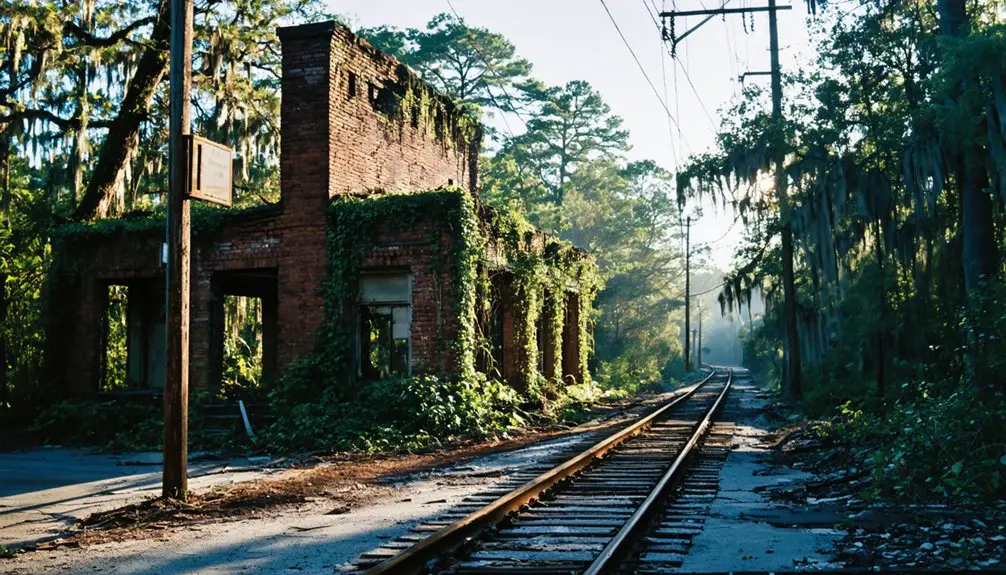You’ll find Andersonville’s remains submerged beneath Lake Hartwell’s waters, where it once flourished as a vibrant river port at the confluence of the Seneca and Tugaloo Rivers. Established in 1801, this South Carolina trading hub prospered through cotton mills and river commerce until devastating floods struck in 1840 and 1852. When Lake Hartwell filled in the 1960s, the town disappeared underwater, though Andersonville Island still holds secrets of this lost settlement’s past.
Key Takeaways
- Andersonville was a thriving river port town established in 1801 at the confluence of Seneca and Tugaloo Rivers in South Carolina.
- Natural disasters, including devastating floods in 1840 and 1852, severely damaged the town’s textile mills and economic infrastructure.
- The town experienced significant decline after railroad companies bypassed it, and the post office closed by 1893.
- Lake Hartwell’s creation in the 1960s completely submerged the historic town, requiring relocation of cemeteries and artifacts.
- Today, only Andersonville Island remains above water, accessible by boat and featuring visible remnants during low water periods.
The Birth of a Trading Hub (1801)
When the South Carolina General Assembly established Andersonville in 1801, they envisioned a bustling trading hub at the strategic confluence of the Seneca and Tugaloo Rivers. The founding significance of this 340-acre settlement, purchased from Jacob Mauldin by Samuel Earle, would soon become apparent.
You’d find Colonel Elias Earle and General Robert Anderson, for whom the town was named, implementing trading strategies that would transform the Upcountry’s commerce. The establishment of a 40-room hotel catered to the growing number of travelers passing through the region.
Positioned near Harrison’s Ferry, the town’s location proved ideal for merchants seeking to move goods between the inland regions and coastal markets. The area became a commercial powerhouse with various local businesses including tailors, wagon makers, and shoe shops.
Strategically situated by Harrison’s Ferry, Andersonville emerged as a vital link between backcountry traders and Charleston’s bustling port.
You could witness boats laden with cotton, animal skins, and medicinal roots like pinkroot and ginseng making their way downstream to Hamburg, then overland to Charleston via the Old Post Road.
Life Along the Rivers: Early Settlement Years
Life along Andersonville’s riverbanks in the early 1800s painted a vibrant picture of frontier settlement, where nature’s rhythms shaped daily existence.
You’d find bustling activity at the confluence of the Tugaloo and Seneca Rivers, where traders navigated vessels laden with cotton, ginseng, and pinkroot downstream to Augusta and Charleston.
The settlement’s early years reflected complex interactions between European settlers and Native American groups, particularly the Cherokee, who’d previously controlled these strategic waterways.
Lesser family merchants, who arrived from Prussia before the Civil War, established successful trading operations along the waterfront.
You’d witness diverse communities forming, from Jewish merchants to Baptist congregations, all adapting to life governed by river commerce and agricultural cycles.
While the rivers enabled prosperity through navigation and trade, they’d also bring devastating floods that tested settlers’ resilience, destroying crucial mills and cotton gins that powered the local economy.
These early river communities faced challenges similar to those documented at Civil War prison camps, though under vastly different circumstances and time periods.
Industrial Growth and Economic Prosperity
You’ll find Andersonville’s early industrial success was built on the strategic placement of cotton mills and manufacturing facilities along the Tugaloo and Seneca Rivers, where water power drove production.
Your glimpse into 1820s Andersonville would have revealed a bustling commercial center with wool factories, tanyards, and various mills capitalizing on river access for trade.
The town’s barge lines transported cotton, leather goods, and manufactured items downstream to Augusta’s markets, establishing Andersonville as a significant trading hub in early 19th century South Carolina.
The Electric City era brought unprecedented industrial growth as Anderson became one of the South’s leading textile manufacturing centers.
The area’s evolution from cotton fields led to diversification with wheat and soybeans becoming major agricultural products that sustained the region’s economic growth.
Cotton Mills Dominate Trade
The rise of cotton manufacturing transformed Anderson from a modest agricultural town into a thriving industrial center during the late 19th century.
You’d find the Anderson Cotton Mills leading this revolution as America’s first textile production facility powered entirely by long-distance electricity from the Portman Shoals Dam.
Founded by a five-man board in 1888, the Anderson Cotton Mill became the first cotton manufacturing plant established in the city.
The industrial heritage of Anderson grew rapidly with Orr Cotton Mills joining in 1899, operating over 57,000 spindles and 1,500 looms by 1909.
Toxaway Mill followed in 1902, employing 150 workers who earned about $5.38 weekly.
Mill villages housed workers and their families, while company stores controlled the economic flow.
The mills’ massive production capabilities turned Anderson into a significant trade hub, with textiles flowing into wider commercial networks and bringing unprecedented prosperity to the region.
A historical marker erected in 1978 commemorates the site’s industrial significance, though only the post remains today.
River Commerce Fuels Growth
While cotton mills powered Anderson’s industrial might, the town’s earliest economic engine lay in its strategic position at the confluence of three essential waterways.
You’d find bustling river routes connecting Andersonville to Augusta and beyond, as barges navigated the Savannah River laden with cotton, animal skins, and manufactured goods. The town’s trade networks expanded through two important ferry operations and a complex of riverside warehouses. Robert Anderson and his partners helped establish the town as a vital trading center. The creation of Lake Hartwell in the 1960s would ultimately submerge this once-thriving commercial hub.
- Water-powered industries thrived, including tanyards, wool factories, and clock manufacturing.
- A 40-room hotel catered to merchants and traders visiting via river routes.
- Multiple mills and factories leveraged the rivers for both power and transport.
This river-based commerce transformed Andersonville into a significant hub of the Upcountry’s economic landscape, fueling unprecedented growth and prosperity during the early 19th century.
Natural Disasters and Their Impact
You’ll find Andersonville’s darkest hours in the devastating floods of 1840 and 1852, which swept away the town’s textile mills and cotton gins with destructive force.
Though local industrialists rebuilt after the first flood, the second deluge proved too costly, leaving the mills in ruins and the town’s economic foundation severely weakened.
The repeated destruction of these essential industries marked the beginning of Andersonville’s decline, as the lack of flood control measures left the community defenseless against nature’s fury.
Devastating Floods Strike Twice
Located at the vulnerable fork of the Seneca and Tugaloo Rivers, Andersonville faced two catastrophic floods in 1840 and 1852 that devastated its burgeoning textile industry.
Despite attempts at flood resilience strategies, the town’s mills couldn’t withstand nature’s fury. Historical flood patterns show this wasn’t unusual for the region – the Pacolet River flood of 1903 killed 65 people and caused $5 million in damage to nearby communities.
- Floodwaters destroyed multiple textile mills, crippling the town’s economic backbone
- The recurring floods contributed to the town’s decline before railroad routes bypassed it
- Similar flooding patterns continue today, as seen with Hurricane Helene’s devastating impact in 2023
These destructive forces of nature ultimately sealed Andersonville’s fate, transforming a once-promising industrial center into a ghost town.
Mill Destruction and Rebuilding
Despite initial hopes of resilience, Andersonville’s textile mills endured a brutal cycle of destruction and rebuilding in the mid-19th century.
After the devastating flood of 1840, you’d have witnessed the community’s determined mill resilience as they reconstructed their essential manufacturing centers. Yet nature struck again in 1852, washing away their hard-fought recovery efforts.
These repeated disasters dealt more than just structural damage – they shattered the economic backbone of the region.
While other South Carolina mills, like Anderson Mill in Spartanburg County, managed to maintain their historical significance through successful rebuilding efforts, Andersonville’s industrial dreams gradually slipped away.
The combination of flood damage, lost machinery, and interrupted manufacturing processes ultimately contributed to the town’s decline, with even its post office closing by 1893.
Economic Recovery Falls Short
The recurring cycle of natural disasters in South Carolina dealt a devastating blow to Andersonville’s hopes for economic recovery.
You’ll find that flood recovery efforts repeatedly fell short, mirroring the challenges seen across the state’s history of devastating natural disasters.
Like the Great Pacolet Flood of 1903, which left thousands without work, Andersonville’s economic challenges proved insurmountable.
- Federal aid focused primarily on infrastructure repairs, leaving businesses and homeowners to fend for themselves
- Recovery costs routinely exceeded available local resources, forcing many residents to abandon their properties
- The destruction of essential manufacturing facilities, much like the historic textile mills, eliminated significant job opportunities
Without adequate disaster assistance and facing mounting economic pressures, Andersonville’s once-thriving community gradually transformed into the ghost town you’ll see today.
The Railroad Era’s Devastating Effect
During the late 19th century, shifting railroad routes dealt a devastating blow to Andersonville’s future as major rail lines favored nearby Greenville and Spartanburg.
The town’s railway competition intensified as the Greenville, Spartanburg & Anderson Railway prioritized larger upstate cities, bypassing Andersonville in favor of more prosperous regional centers.
You’d have seen the transportation decline accelerate when the ambitious Blue Ridge Railroad project, meant to connect Anderson to Knoxville through the Stumphouse Mountain Tunnel, stalled and never materialized.
The Civil War’s outbreak diverted resources, and post-war efforts couldn’t revive the project.
Meanwhile, neighboring towns like Pelzer, Belton, and Williamston flourished with their robust rail connections, drawing industry and residents away from Andersonville.
From Bustling Port to Abandoned Town
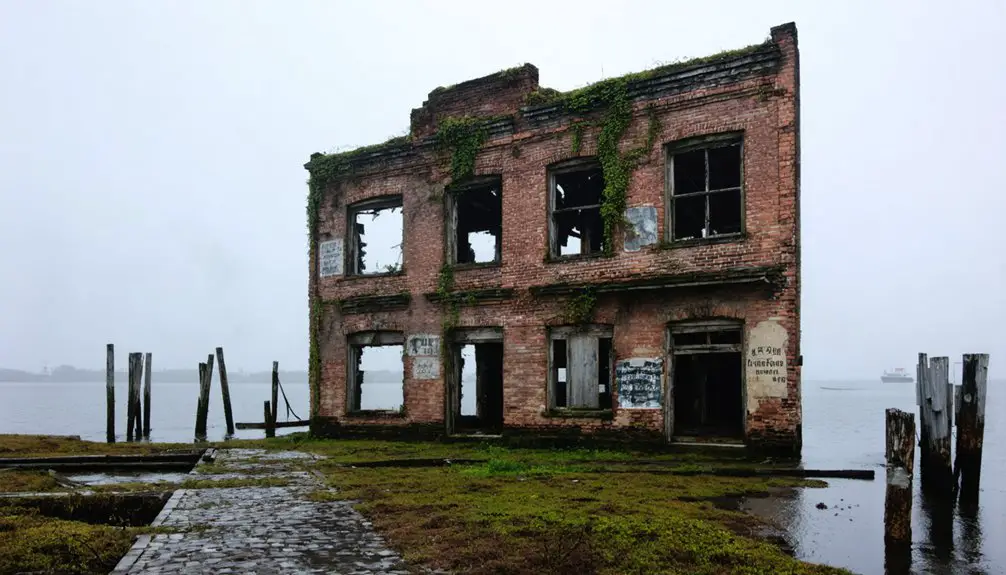
Nestled at the convergence of the Tugaloo and Seneca Rivers, Andersonville emerged in 1801 as a promising river port that would rival any settlement in South Carolina’s Upcountry. The town’s economic importance thrived through its diverse industries and bustling trade, with a 40-room hotel welcoming merchants and travelers alike.
– A prosperous Female Academy, religious institutions, and commercial shops created a vibrant community life.
The town’s economic decline began with devastating floods in 1840 and 1852, destroying essential textile mills.
Without railroad access and plagued by recurring floods, Andersonville’s historical significance faded.
Beneath Lake Hartwell’s Waters
In early 1960, Lake Hartwell’s rising waters submerged the once-thriving town of Andersonville beneath its depths, transforming centuries of history into an underwater time capsule.
Today, you’ll find building foundations, old roads, and even grave markers hidden beneath the lake’s surface, where divers and fishermen regularly report encounters with this submerged history.
Beneath Lake Hartwell’s placid waters lie silent streets and storied foundations, their secrets shared by those who venture below.
Two islands remain as reminders of Andersonville’s past: the main Andersonville Island, stretching two miles long, and the mysterious Cemetery Island, where 57 graves were relocated before the flooding.
Local legends speak of ghost sightings near these islands, with visitors reporting phantom lights, unexplained knocking sounds, and distant singing during full moons.
Some say the spirit of Sarah Grey Eagle Bruin still watches over Cemetery Island, while divers often sense an eerie presence near the underwater ruins.
Relocating the Past: Cemetery and Artifacts
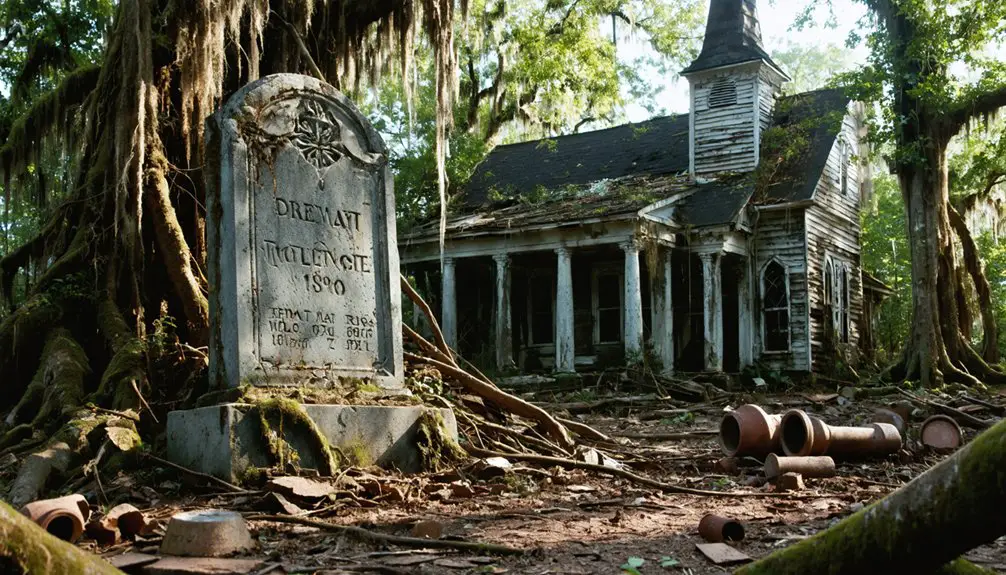
Before Lake Hartwell‘s waters could claim Andersonville forever, officials undertook a massive relocation effort to preserve the town’s cemetery and artifacts. Following cemetery ethics, they carefully moved most burials to Andersonville Baptist Church on the lake’s eastern shore, ensuring respect for early settlers and maintaining essential genealogical records.
- Divers and researchers managed to salvage various artifacts, including textile mill remnants and trade goods, though underwater conditions limit ongoing recovery.
- The relocated cemetery now serves as a significant community memorial, preserving the heritage of Revolutionary War veterans like Robert Anderson.
- Historical artifacts discovered range from cotton mill equipment to household items, offering glimpses into Andersonville’s industrial and domestic life.
You’ll find these preserved pieces of history in local museums and historical societies throughout Anderson County, though many artifacts remain beneath Lake Hartwell’s waters.
Legends of the Submerged Settlement
While Lake Hartwell’s waters conceal most of Andersonville’s physical remnants, the submerged settlement has spawned countless tales of mysterious encounters and supernatural phenomena.
You’ll hear locals speak of ghostly apparitions wandering the shoreline near the old town site, particularly on quiet nights when the lake’s surface lies still and glassy.
Fishermen and divers report phantom lights dancing beneath the water’s surface, especially near the submerged structures and cemetery.
You might feel an unexplained presence watching you while exploring the underwater ruins, as many visitors have reported.
These eerie encounters have woven themselves into the fabric of local folklore, keeping Andersonville’s spirit alive long after its physical structures disappeared beneath Lake Hartwell’s depths.
Modern Day Andersonville Island
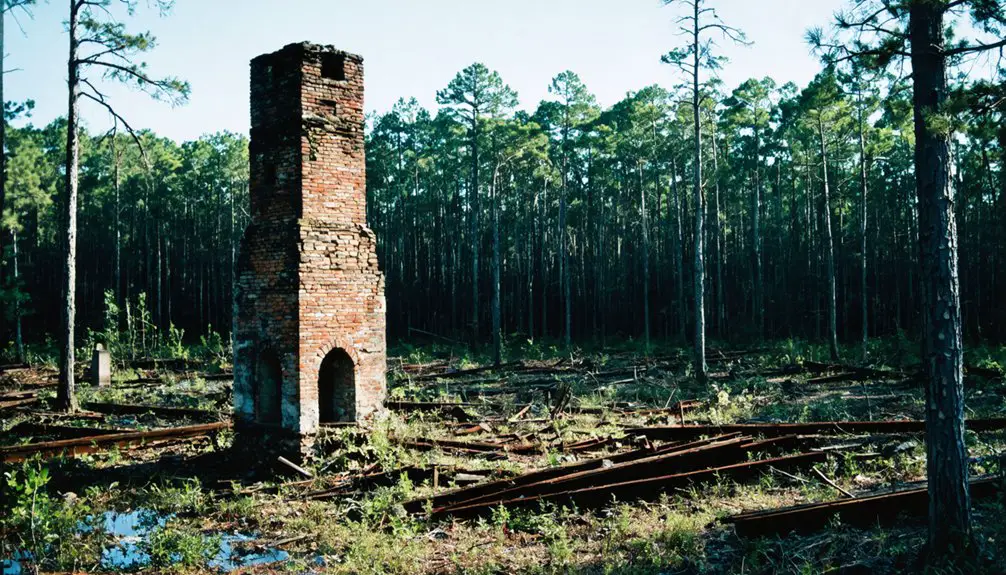
If you’re planning to visit Andersonville Island today, you’ll find a narrow two-mile stretch of land that’s all that remains visible of the once-thriving town.
You can reach the island by boat or kayak, where building ruins and remnants of the Southern Clock Factory‘s era still dot the landscape.
During periods of low water in Lake Hartwell, you’ll spot old road beds and bridges connecting to the mainland, offering glimpses of the community that existed before the 1960s flooding.
Current Island Access
Modern-day access to Andersonville Island presents unique logistical challenges, as the historic town site now lies submerged within Lake Hartwell’s waters.
You’ll need watercraft to reach this two-mile-long island, with Five Forks Recreational Area serving as your primary launch point. The journey requires careful planning, as you’re facing a substantial 9-mile paddle one way if you’re not using a motorized vessel.
- Motor boats provide the most practical transportation option due to the distance and open water conditions
- No public docks or facilities exist on the island, so you’ll need to be self-sufficient
- Access may be restricted during certain periods due to state regulations and emergency orders
The island’s remote location and lack of infrastructure maintain its isolation, preserving the ghostly quiet of this former bustling riverside town.
Remnants Above Water
Despite Lake Hartwell’s flooding of the original town site, Andersonville Island stands as the sole remaining above-water landmass of this once-thriving riverside community.
Today, this narrow two-mile stretch of higher ground serves as a symbol of the town’s legacy, offering opportunities for island exploration among scattered remnants of its past.
While no buildings remain standing, you’ll discover traces of old foundations, crumbling masonry, and hints of former roadways beneath the island’s natural overgrowth.
These fragments of history, occasionally revealed through erosion or seasonal water level changes, tell stories of the submerged town’s industrial heritage.
Though most historical preservation efforts focused on relocating the town cemetery to Andersonville Baptist Church, the island itself holds untapped archaeological potential, preserving clues about life in this vanished river port community.
Frequently Asked Questions
What Was the Total Population of Andersonville During Its Peak Years?
All that glitters isn’t gold when tracking population growth. While you’ll find historical significance in Andersonville’s peak, you can’t pinpoint exact numbers, though estimates suggest between several hundred to low thousands.
Are There Any Living Descendants of Original Andersonville Families Today?
While descendant research hasn’t confirmed any specific living heirs, you’ll find that family connections likely exist in Anderson County and nearby regions, though no one’s publicly documented their Andersonville ancestry.
What Specific Native American Tribes Inhabited the Area Before Andersonville?
You’ll find Cherokee history dominates the area, with their lower towns established after 1500. Earlier, Etowah Indians lived there around 1100, while Muskogean tribes and elements of Catawba culture appeared between 1350-1600.
How Deep Underwater Are the Remains of Andersonville Buildings?
While underwater archaeology reveals ruins at various depths, you’ll find most of Andersonville’s historical remains around 130 feet beneath Lake Hartwell’s surface, similar to other submerged structures requiring expert diving for preservation.
Were Any Valuable Artifacts Recovered Before Lake Hartwell Flooded the Town?
You’ll find no records of significant artifacts discovered before flooding. While locals relocated the cemetery and church, there’s no evidence of valuable historical items being recovered from the town site.
References
- https://lakehartwellguide.com/exploring-the-ghost-town-of-andersonville-lake-hartwells-sunken-mystery/
- https://www.rootsandrecall.com/anderson/buildings/andersonville-andersonville-island/
- https://en.wikipedia.org/wiki/Andersonville
- https://kids.kiddle.co/Andersonville
- https://sctravelguide.com/2018/06/11/south-carolina-ghost-towns/
- https://www.randomconnections.com/paddling-to-andersonville/
- http://nationalregister.sc.gov/SurveyReports/AndersonCounty2002-2SM.pdf
- https://www.youtube.com/watch?v=8fl284YksEk
- https://www.isjl.org/south-carolina-anderson-encyclopedia.html
- http://www.oldpendleton.scgen.org/history.html
